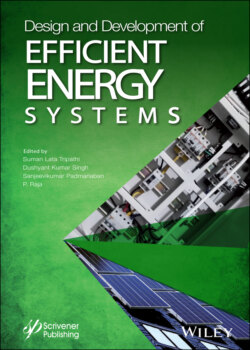Читать книгу Design and Development of Efficient Energy Systems - Группа авторов - Страница 2
Table of Contents
Оглавление1 Cover
2 Title Page
3 Copyright
4 Preface
5 1 Design of Low Power Junction-Less Double-Gate MOSFET 1.1 Introduction 1.2 MOSFET Performance Parameters 1.3 Comparison of Existing MOSFET Architectures 1.4 Proposed Heavily Doped Junction-Less Double Gate MOSFET (AJ-DGMOSFET) 1.5 Heavily Doped JL-DG MOSFET for Biomedical Application 1.6 Conclusion References
6 2 VLSI Implementation of Vedic Multiplier 2.1 Introduction 2.2 8x8 Vedic Multiplier 2.3 The Architecture of 8x8 Vedic Multiplier (VM) 2.4 Results and Discussion 2.5 Conclusion References
7 3 Gas Leakage Detection from Drainage to Offer Safety for Sanitary Workers 3.1 Introduction 3.2 Related Works 3.3 Methodology 3.4 Experimental Results 3.5 Conclusion References
8 4 Machine Learning for Smart Healthcare Energy-Efficient System 4.1 Introduction 4.2 Related Works 4.3 Edge Computing 4.4 Smart Healthcare System 4.5 Conclusion and Future Directions References
9 5 Review of Machine Learning Techniques Used for Intrusion and Malware Detection in WSNs and IoT Devices 5.1 Introduction 5.2 Types of Attacks 5.3 Some Countermeasures for the Attacks 5.4 Machine Learning Solutions 5.5 Machine Learning Algorithms 5.6 Authentication Process Based on Machine Learning 5.7 Internet of Things (IoT) 5.8 IoT-Based Attacks 5.9 Information and Identity Theft 5.10 Social Engineering 5.11 Denial of Service 5.12 Concerns 5.13 Conclusion References
10 6 Smart Energy-Efficient Techniques for Large-Scale Process Industries 6.1 Pumps Operation 6.2 Vapour Absorption Refrigeration System 6.3 Heat Recovery Equipment 6.4 Lighting System 6.5 Air Conditioners 6.6 Fans and Other Smart Appliances 6.7 Motors 6.8 Energy-Efficient Transformers References
11 7 Link Restoration and Relay Node Placement in Partitioned Wireless Sensor Network 7.1 Introduction 7.2 Related Work 7.3 Proposed K-Means Clustering Algorithm 7.4 System Model and Assumption 7.5 Results and Discussion 7.6 Conclusions References
12 8 Frequency Modulated PV Powered MLI Fed Induction Motor Drive for Water Pumping Applications 8.1 Introduction 8.2 PV Panel as Energy Source 8.3 Multi-Level Inverter Topologies 8.4 Experimental Results and Discussion 8.5 Conclusion and Future Scope References
13 9 Analysis and Design of Bidirectional Circuits for Energy Storage Application 9.1 Introduction 9.2 Modes of Operation Based on Main Converters 9.3 Proposed Methodology for Three-Phase System 9.4 Conclusion References
14 10 Low-Power IOT-Enabled Energy Systems 10.1 Overview 10.2 Empowering Tools 10.3 Internet of Things within Power Region 10.4 Difficulties - Relating Internet of Things 10.5 Upcoming Developments 10.6 Conclusion References
15 11 Efficient Renewable Energy Systems Introduction 11.1 Renewable-Based Available Technologies 11.2 Adaptability Frameworks 11.3 Conclusion References
16 12 Efficient Renewable Energy Systems 12.1 Introduction 12.2 Sources of Energy: Classification 12.3 Renewable Energy Systems 12.4 Solar Energy 12.5 Wind Energy 12.6 Geothermal Energy 12.7 Biomass 12.8 Ocean Power 12.9 Hydrogen 12.10 Hydro Power 12.11 Conclusion References
17 13 Agriculture-IoT-Based Sprinkler System for Water and Fertilizer Conservation and Management 13.1 Introduction 13.2 Development of the Proposed System 13.3 System Description 13.4 Layers of the System Architecture 13.5 Calibration 13.6 Layout of the Sprinkler System 13.7 Testing 13.8 Results and Discussion 13.9 Conclusion References
18 14 A Behaviour-Based Authentication to Internet of Things Using Machine Learning 14.1 Introduction 14.2 Basics of Internet of Things (IoT) 14.3 Authentication in IoT 14.4 User Authentication Based on Behavioral-Biometric 14.5 Threats and Challenges in the Current Security Solution for IoT 14.6 Proposed Methodology 14.7 Conclusion and Future Work References
19 15 A Fuzzy Goal Programming Model for Quality Monitoring of Fruits during Shipment Overseas 15.1 Introduction 15.2 Proposed System 15.3 Work Process 15.4 Optimization Framework 15.5 Creation of Database and Website 15.6 Libraries Used and Code Snipped 15.7 Mode of Communication 15.8 Conclusion Abbreviations References
20 16 Internet of Things – Definition, Architecture, Applications, Requirements and Key Research Challenges 16.1 Introduction 16.2 Defining the Term Internet of Things (IoT) 16.3 IoT Architecture 16.4 Applications of Internet of Things (IoT) 16.5 Requirement for Internet of Things (IoT) Implementation 16.6 Key Research Challenges in Internet of Things (IoT) References
21 17 FinFET Technology for Low-Power Applications 17.1 Introduction 17.2 Exiting Multiple-Gate MOSFET Architectures 17.3 FinFET Design and Analysis 17.4 Low-Power Applications 17.5 Conclusion References
22 18 An Enhanced Power Quality Single-Source Large Step-Up Switched-Capacitor Based Multi-Level Inverter Configuration with Natural Voltage Balancing of Capacitors 18.1 Introduction 18.2 Suggested Topology 18.3 Cascaded Configuration of Suggested Topology 18.4 Modulation Technique 18.5 Power Loss Analysis 18.6 Design of Capacitors 18.7 Comparative Analysis 18.8 Simulation Results 18.9 Conclusions References
23 Index
24 End User License Agreement
